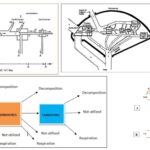Virology 107 Views 1 Answers
Sourav PanLv 9October 28, 2024
Describe the Basic Structure of Viruses
Describe the Basic Structure of Viruses
Please login to save the post
Please login to submit an answer.
Sourav PanLv 9May 15, 2025
Viruses are unique acellular entities characterized primarily by their composition of nucleic acids and proteins. While some viruses may also include small amounts of lipids and polysaccharides, their fundamental structure consists of a viral core, a viral capsid, and, in certain cases, an envelope. The size, morphology, and structure of viruses are crucial for viral classification and the diagnosis of viral infections.
- Viral Core
- The viral core represents the nucleic acid component of the virus, which constitutes its genome.
- This core is essential as it contains the genetic information responsible for the virus’s pathogenicity, antigenicity, replication, heredity, and variation.
- Depending on the type of nucleic acid, viruses are classified as either DNA viruses or RNA viruses.
- The nucleic acid can be single-stranded or double-stranded, influencing the virus’s replication strategy.
- The molecular mass of the viral core typically ranges from 2 to 160 × 10^6 Daltons.
- Viral Capsid
- The viral capsid functions as a protective protein shell that encases the viral nucleic acid.
- In some cases, this capsid is associated with the viral nucleic acid, forming a structure referred to as the nucleocapsid.
- For non-enveloped viruses, the nucleocapsid constitutes the entire virus.
- The capsid is composed of repeated protein subunits known as capsomeres, which may consist of one or more types of proteins that serve as structural components.
- The arrangement and composition of these capsomeres play a significant role in determining the shape and stability of the virus.
- Envelope
- The envelope is an additional layer found in some viruses, forming one or two membranes that encircle the capsid, distinguishing enveloped viruses from non-enveloped ones.
- This envelope is acquired during the maturation phase when the virus buds from the host cell’s membrane, allowing the virus to incorporate components of the host cell’s lipid bilayer.
- Consequently, the envelope can consist of material derived from either the host cell membrane or the nuclear membrane.
- Many viral envelopes are adorned with protein protrusions known as peplomers or spikes, which are essential for the virus’s ability to attach to and penetrate host cells.
0
0 likes
- Share on Facebook
- Share on Twitter
- Share on LinkedIn
0 found this helpful out of 0 votes
Helpful: 0%
Helpful: 0%
Was this page helpful?




